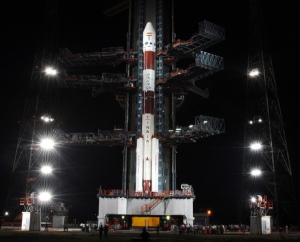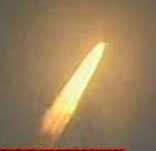Perfect start - Chandrayaan in earth orbit
22 Oct 2008
Spaceport Sriharikota: India's lunar mission got off to a perfect start with lunar orbiter Chandrayaan-1 put into its designated orbit around the earth this Wednesday morning. ISRO scientists described the launch as a copybook liftoff, and with it India has now joined the elite club of six nations that has sent missions to the moon.
 Other members of the club are the US, former Soviet Union, European Space Agency, China and Japan.
Other members of the club are the US, former Soviet Union, European Space Agency, China and Japan.
The Chandrayaan-1 is also carrying NASA and European payloads.
Speaking minutes after the successful liftoff from this spaceport off the Andhra Pradesh coast, about 80 km north of Chennai, chairman of the Indian Space Research Agency (ISRO) G. Madhavan Nair described the moment as "historic. India has started its journey to the moon. The first leg has gone perfectly… the spacecraft has been launched into orbit."
The 44.4-metre-tall 316-tonne rocket, Polar Satellite Launch Vehicle (PSLV-C11), had a copybook launch at 6.20 am and placed the lunar orbiter Chandrayaan-1 into its scheduled orbit around the earth in 18 minutes, as planned. This is the 13th straight successful launch for ISRO's workhorse rocket.
ISRO scientists had the jitters with heavy rain lashing the region around the spaceport over the last four days. But the weather eased off by Tuesday evening and the launch took place in a cloudy morning sky.
Chandrayaan-1 has begun to orbit the earth in a geostationary transfer orbit (GTO), from where it will eventually transfer to a lunar orbit, 387,000 km from earth, on 8 November. This will be achieved through a series of complex manoeuvres involving the firing of its onboard liquid apogee motor (LAM).
With the 44.4-metre rocket soaring into the skies amid flames and smoke over1,000 ISRO scientists erupted in joy and excitement. The entire top team of ISRO present on the occasion, led by Madhavan Nair, space centre director MC Dathan, associate director MYS Prasad and others shook hands and hugged one another.
Also present on the occasion were former ISRO chairmen UR Rao and K Kasturirangan and space commission member Roddam Narasimaiah.
Once the 1,380-kg Chandrayaan-1 nears the moon, deceleration will be effected to allow the gravity of the moon to capture the lunar orbiter and put it into an elliptical orbit.
 Chandrayaan-1 is designed to orbit the moon for two years, though it will complete all scheduled experiments and missions in a period of 18 months. It carries 11 payloads - five of Indian origin and six foreign. Of these two payloads are from NASA, three from the European Space Agency (ESA) and one from the Bulgarian Academy of Sciences.
Chandrayaan-1 is designed to orbit the moon for two years, though it will complete all scheduled experiments and missions in a period of 18 months. It carries 11 payloads - five of Indian origin and six foreign. Of these two payloads are from NASA, three from the European Space Agency (ESA) and one from the Bulgarian Academy of Sciences.
According to ISRO scientists, the orbiter will eject the Moon Impact Probe (MIP) towards the lunar surface at the earliest opportunity once it settles into orbit 100 km above the surface of the moon. The MIP, apart from sending back data on its way down, will also carry the Indian flag.
Chandrayaan-1 will conduct high resolution imaging of the moon in the visible, near infrared, microwave and x-ray regions of the electromagnetic spectrum, according to mission director M Annadurai.
A three-dimensional atlas of the lunar surface and chemical mapping of the entire lunar surface are the other objectives of the mission.
India's mission to the moon will be the world's 68th. Of these, 64 have been launched by the US and the former USSR alone. China and Japan launched their respective moon missions Chang'e and Kaguya in September and October last year, while the ESA had launched a mission from November 2004 to September 2006 with SMART (Small Missions for Advanced Research in Technology).
A significant difference for the workhorse PSLV rocket was the fact that this version, the C-11, weighed 22 tonnes more than the earlier models, as its six strap-on motors were 3.5 metres bigger at 13.5 metres. As a result the rocket carried 12 tonnes of solid propellant against the usual nine tonnes.
"The vehicle structure was altered to have bigger strap-on motors. The rocket is also padded up with additional thermal insulation," George Koshy, project director, told the media.













.jpg)






.jpg)









